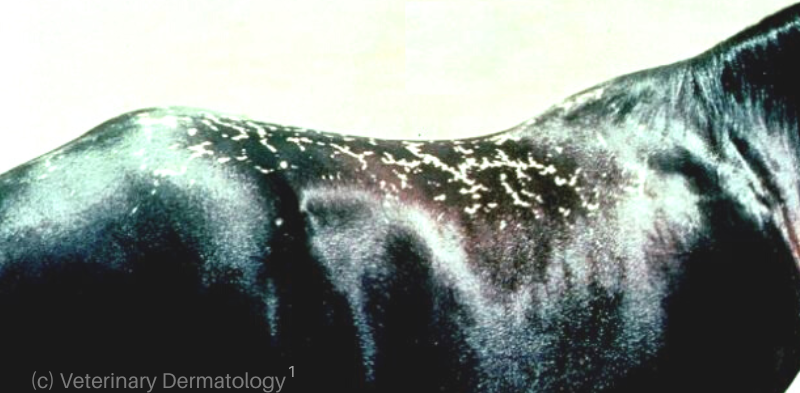

White lacing patterns on either side of the horse’s spine: it’s amazing how many different explanations there are for this interesting coat change.
Even in veterinary texts, the definitions don’t always completely correspond.
After stumbling through my own misinterpretations some years back, I started to collect photos and descriptions in an effort to make sense of this – and to help my clients understand too.
So belt up and strap yourself in for a high speed run through the world of lacing – official name leukotrichia.
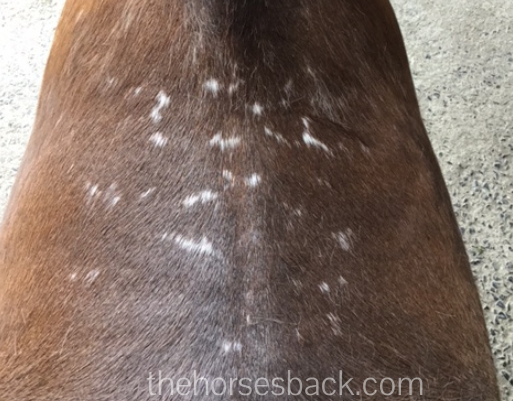
First, what does lacing look like?
The name gives a strong hint, and the photos show it well, but basically these are linked white lines following a lace, herringbone or giraffe pattern (take your pick). Another term I’ve read is snowflakes (sweet!).
The pattern is generally symmetrical in its location, appearing on both sides of the spine. There may also be white hair patches along the spine itself.
Extending outwards, lacing often extends through the saddle area towards the tail, although smaller areas can also be seen.
The condition’s official name(s)
The umbrella term for these patterns of white markings that continue along and alongside the spine is Leukotrichia (spelled with either a ‘k’ or a ‘c’). ‘Leuko’ means white and ‘trichia’ means hair.
The lacing pattern is termed Reticulated leukotrichia – reticulated means ‘to resemble a net or a network’. When the pattern is seen in generations Quarter Horses or Paints, this is what is being genetically inherited. There is no pain associated with this.
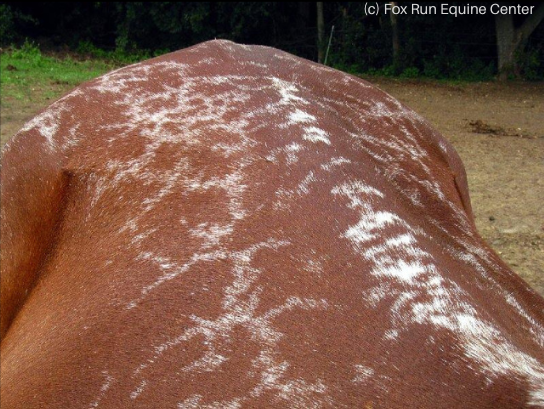
Now, there’s a different group that we’ve already touched on. When the horse has sore, crusted patches sized 1-4 cm, the condition is known as Hyperesthetic leukotrichia. Hyperesthetic refers to an unusual or pathological, often painful, sensitivity of the skin.
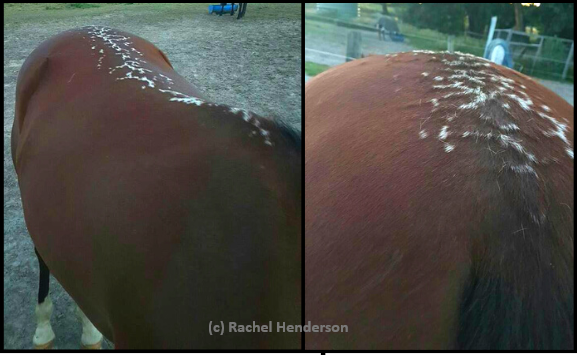
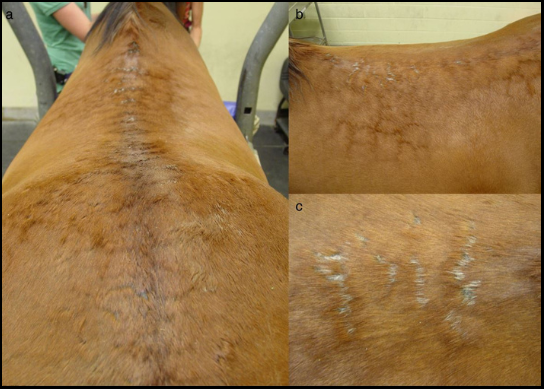
There’s one more version: when it presents as white spots sized 1-3cm along the back it’s called (wait for it) Spotted leukotrichia. And yep, those are the ‘birdcatcher’ spots that make a gradual appearance over time, usually in chestnut horses (which suggests the co-presence of a certain gene in these horses).
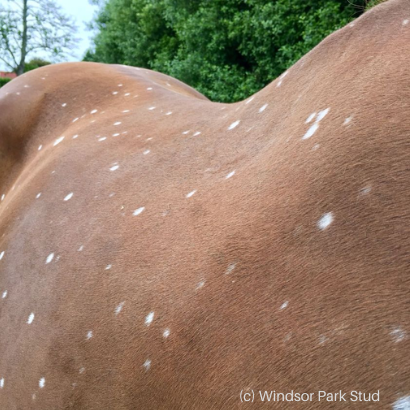
How lacing first appears
Leukotrichia usually begins around the base of the withers and grows towards the tail, extending itself year-on-year.
Yes, it grows. How strange is that?
In cases of Hyperesthetic leukotrichia, a few areas of coat may become raised, with edema (fluid) beneath and the skin underneath growing sore. Crusts can develop. This is a variation – but we’ll come to that. As these lesions heal over the course of 1-3 months, the skin settles back down and the soreness eases. White hair grows through in what becomes a permanent colour change.
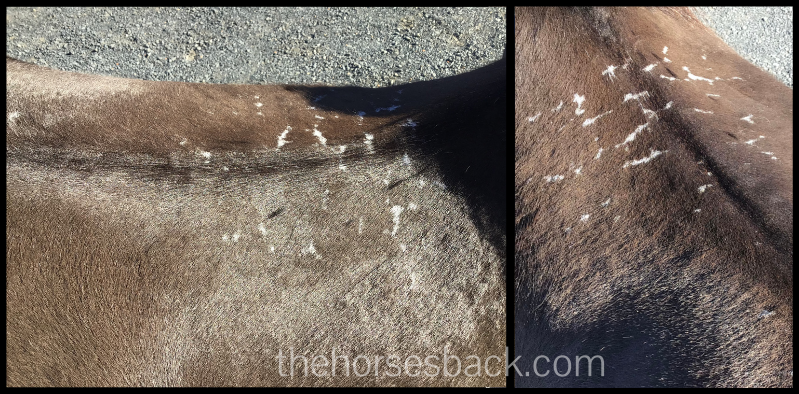
What causes lacing?
You may have heard one or more of the following explanations from veterinarians.
- Genetics in certain breeds (usually QHs, but also Arabians).
- Allergic reactions.
- Responses to vaccines.
- Reaction to viruses, including equine herpes.
I have met some horses that fit one of the above, and some that fit none.
I have simply been lucky enough to see quite a few, including its initial appearance in an Arabian yearling.
One veterinary theory is that the painful version is an immune-mediated skin reaction that follows an infection or another trigger – but there are no studies to provide evidence for this. In fact, one says it’s unrelated [2].
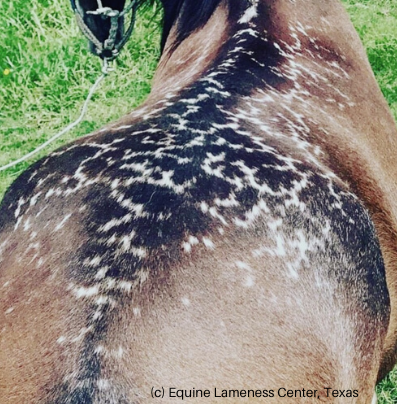
One more surprising possibility…
Just to stir things up a bit, an unusual Indian study reported cases of sun-induced Reticulated leukotrichia. 47 working horses and ponies were kept tethered for several hours a day with the sun on their left side for 8-15 months.
Guess what? They developed more lacing on the left side of their backs over the course of 8-15 months.
The photos are poor quality, but I’ve tweaked settings to show the lacing more clearly.
This wasn’t set up as a scientific study, but it’s extremely interesting. Leukoderma has been linked to sun damage [3], but ths is clearly leukotrichia.
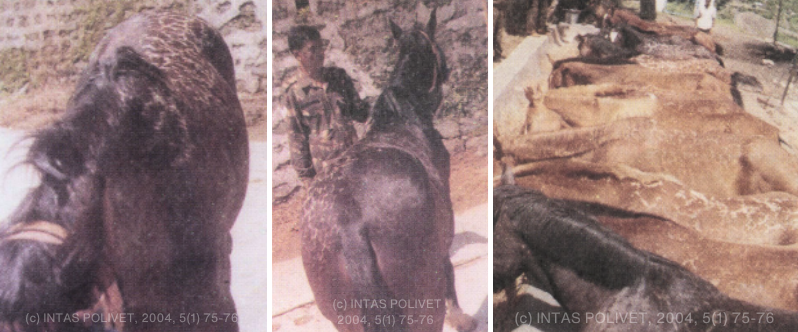
What DOESN’T cause lacing?
You may also hear some of the following explanations.
- Badly fitting saddles.
- Pressure sores from other causes.
- Back trauma.
- Scarring from itching.
- Parasites.
While the above can certainly cause white hairs through skin damage, they’re not responsible for the lacing we’re looking at here.
And of course yes, they can be present at the same time, but they’re still not the cause. Correlation does not equal causation!
With the appearance of lacing in certain breeds and in horses of certain colors, all we know is that those breeds or lines carry the same collection of genes.
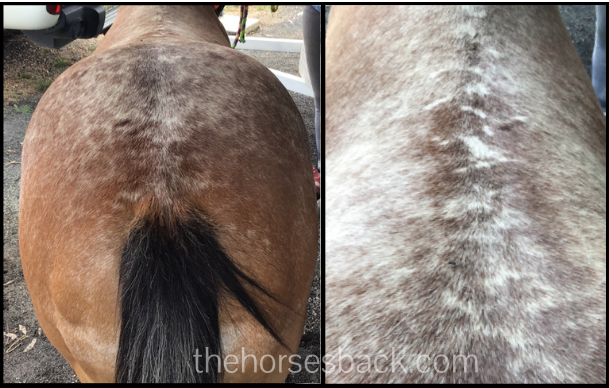
With Hyperesthetic leukotrichia, histopathology tests on active lesions show that a dermatological condition exists – i.e. a physical reaction is happening – without the precise cause or etiology being known. (Read more about the lengthy process of skin condition diagnosis here.)
What’s the outlook?
Many horses with Reticulated leukotrichia have the lacing, with no issues at all.
In the case of Hyperesthetic leukotrichia, there’s no way to stop the painful lesions appearing as the lacing develops.
This leaves us with providing topical skin management when painful lesions appear, keeping them clean and avoiding secondary infection, while not disturbing crusts.
This also means not brushing the painful area. If your horse is intensely sore, you may need to avoid placing a saddle on that painful skin as well.
The good news is that once the lesions are healed and the white hair grows through, horses don’t seem to experience any further pain.
And now you have yourself a talking point for the rest of your days together…
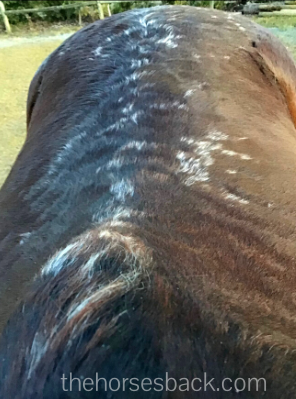
References
[1] Pigmentary Disorders. Veterinary Dermatology. 2000, 11:205-210. https://doi.org/10.1046/j.1365-3164.2000.00226.x
[2] Goodale EC, White SD, Outerbridge CA, Everett AD, Affolter VK. A retrospective review of hyperaesthetic leucotrichia in horses in the USA. Veterinary Dermatology. 2016, 27(4):294-e72. doi: 10.1111/vde.12327
[3] Rashmir-Raven, AM, Equine Internal Medicine (4th ed). 2018.
.
.
